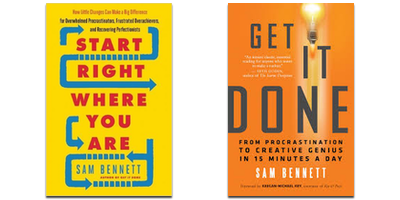
Disappointment is, literally, failing to keep an appointment. Which is why I think it hurts a little more than the other bumps and bruises of life.
When you feel disappointed, you are feeling deprived of something you thought was already in motion. If you’re feeling like you have an “appointment” with a promotion or a successful presentation or a new love, having that thing not work out is especially crushing because it was kind of a done deal inside your mind.
And that old saw about “don’t get your hopes up, and that way you won’t get disappointed,” is the biggest bunch of hooey I’ve ever heard.
First of all, it’s a bad strategy because it plain doesn’t.
If something you want doesn’t work out, you’re going to be bummed whether or not you had anticipated the failure.
And missing an opportunity to have delightfully high hopes seems. . . churlish.
I understand the impulse to say, “I just don’t want to get hurt again.” But guess what? You’re here to get hurt.
We’re here to try again. and again. and again. We’re here to gain resiliency.
So I say go ahead — get your hopes up. Dream big, lush, vivid dreams. Imagine your ideal of success with the full knowledge that reality may never measure up.
Then when things do work out, you haven’t wasted one moment tamping down your enthusiasm. And if they don’t work out, well, then, you are free to feel the full force of your disappointment. Which may or may not be as bad as you had imagined it might be.
I bet that if you stacked up all your disappointments you would you would find that very few of them make you think, “Oh, I wish I hadn’t even tried that.” I bet you would mostly think, “Well, I sure learned a lot.”
And that’s the other thing we’re here for: our soul’s education.
Nevertheless, disappointments can leave deep scars. And some disappointments take longer to heal than we’d like, even when we know we “should be over it by now.”
(Over it by now? Says who? What is this mysterious global time frame on getting over things? Honestly.)
Disappointment is a wise and valuable teacher. It acquaints you with grief. Grief, said the Greeks, is the daughter of anger and sadness. These two powerful emotions need to be felt, explored, and lived through.
Otherwise we are only a living shadow of our true selves: pretending we don’t care about the things we care about most.
So there’s a time to cry and a time to stop crying.
photo credit: A.K. Photography via photopin cc

Another block to creativity are the ghosts of failures past.
A client once told me, “I’m afraid to get my work out there because the last time I tried, I was sabotaged and betrayed by a group of women I had trusted.”
I said, “I’m so sorry that happened. That must have been excruciatingly painful. But I’m noticing that there is no group of women holding you back now. It is you holding you back. You are sabotaging and betraying yourself.”
She launched her new business exactly seven days later.
Almost every working creative person I know has a story about the overly critical teacher, the cruel playground remark, or the scathing review that made them feel like quitting.
Some of these slights were imagined, some were real, and some were richly deserved.
After all, even the best artists fail from time to time.
But if you let the ghosts of your failures, errors, and wrongs derail you, they will define you.
You have the power to exorcise those ghosts, but it will take determination and persistence.
You must first notice when those ghosts take control, and then mentally paint them pink. Now you have hot-pink ghosts — they seem a bit lighter and sillier, yes?
Good. Now call to mind a memory of one of your great successes, a time you felt valued, gifted, and good inside. Really dive into this memory and let the feeling of it suffuse your body.
Repeat this process any time those old pink ghosts threaten to keep you stuck again.
photo credit: waferbaby via photopin cc

Exercise:
1. Write down all the activities that you typically do in a day, such as:
drive in the car pool
do laundry
pay bills
make phone calls
write
work out
get the mail
read
work with clients
play with the kids
plan upcoming travel
coordinate volunteers for charity event
go to the grocery store
cook supper
watch TV
2. Now put an asterisk next to the tasks that only you can do.
So the asterisked items might be:
write
work out
read
work with clients
play with the kids
3. Find a way to get the un-starred items off your plate.
You may need to hire someone, or you may need to simply ask some of the other grown-ups in your life for help.
Teach the kids to do the laundry, and get a co-chair to work with the volunteers.
Yes, you will have to get over some of your perfectionism — nobody else is going to do as good a job cooking dinner or sorting the laundry as you do.
But guess what? You have bigger fish to fry.
Your creative life is never going to take precedence over your everyday life unless you make it happen.

“It’s big, R.J.! Big!” says the screenwriter to the old-time Hollywood producer.
Your vision may also have first appeared to you in breathtaking Cinemascope and stereophonic sound.
But you may be paralyzing yourself with the grandiosity of your vision.
Reducing the size of your project might free you up.
So rather than trying to create an international convention of lute lovers complete with presentations, performances, and a trade fair, perhaps you could host a gathering in your home for ten to twelve lute lovers.
This strategy is especially effective for test-driving Big Ideas.
I once had a client named Virginia who had dreams of opening a dance studio. Before she knew it, she was knee-deep in commercial real estate brochures and cumbersome questions about insurance and employee compensation. She was, to put it mildly, discouraged.
After some discussion of what about her initial idea had so engaged her (“working with young artists,” “bringing spirituality and dance together,” and “giving real, practical help and advice — after all, I was a dancer, too — I’ve been there!”), she realized that she could begin by offering a one-day intensive workshop.
Her church would be happy to rent her a space very inexpensively, and suddenly the idea of only having to get fifteen dancers in a room for one day seemed very doable.
Eventually, Virginia did open a dance studio that focused on the intersection of movement and spirituality, but she ended up doing it through her church, thus saving her a million administrative headaches and allowing her to focus on the part of the work that truly inspired her: teaching.
Increase the Scope of Your Project
Maybe you’re stuck because you’re bored. You’ve been thinking too small.
Perhaps rather than trying to sell your jewelry at local craft fairs, it might be more exciting to sell your items online to a global audience of moneyed fans.
Maybe rather than auditioning for the local community chorus, you’d like to book an evening at a piano bar and offer your very own one-person cabaret show.
Try this: Write down a number-related aspect of your goal, then add a zero.
So if you’ve been thinking you’d like to make $10,000, what happens when you open up to the idea of making 100,000?
If you’re working on selling five or ten of something, what does selling fifty or a hundred look like?
Rather than trying to grow your email list a person at a time, what if you found a way to grow your list a thousand people at a time?
Thinking big gets you out of your self-imposed limitations. You stop thinking about what’s possible for you to accomplish on your own, and you start thinking about what’s needed for this quantum leap to happen.
“What does the project need?” is a much more fruitful question than “How do I do this by myself?”
Ask any successful creative entrepreneur her secret and every single one will tell you, “I got out of the way of the vision.”
Action Step
Write down three to five variations in scope of your project and see which size project feels like the best fit.
(Note: Don’t worry about what you think you are capable of doing; just pick the one that makes your heart go thump thump thump and live with the idea for a while.)
After you’ve done the exercise, come back and leave a comment. I would love to see what you came up with!
Here’s an example of the kind of letter I frequently receive from my clients:
I know what I need to do, I just can’t make myself do it. I watch endless YouTube videos, I play computer solitaire, I fool around on Facebook — I even scrub my kitchen floors — all just to avoid the work that I know is my destiny. I get so mad at myself. Am I chasing a shadow goal? What do I do? — Elizabeth
Here’s what I would say to Elizabeth, and to you, since chances are fairly high you are dealing with the same concerns:
Rest easy, honey — you are merely suffering from a biological imperative called “displacement activity.”
Displacement activity is what happens when an animal is in the grip of two conflicting instincts, and so it enacts a third, seemingly inappropriate behavior.
For example, you’ve probably seen a chimpanzee being challenged by another chimpanzee. When the first chimp doesn’t know whether to run away or fight, he might scratch his head. . .yawn. . . look away. . . start grooming himself.
Seems like a very passive response to aggression, but that chimp will do anything to deflect the energy, avoid making a decision, and otherwise make himself as invisible as possible.
When you have the instinct to create and you simultaneously have the instinct not to create, your fear says, “Don’t do it!” And so, confused by these two equally strong instincts, you shut down and get stuck playing an online word game for hours on end.Sometimes years.
It doesn’t mean you have low self-esteem, and it doesn’t mean your dream is impossible, and it certainly doesn’t mean you’re lazy.
So the next time this happens, just recognize the dynamic without yelling at yourself.
“Ah,” you might say instead, “I appear to be having the instinct to create something. And I also find myself feeling afraid of what will happen if I create that thing.
Perfectly natural.
But my fear does not get to make my decisions for me. So I will now set my kitchen timer for fifteen minutes and just play around with my creative idea in a light, fun, beta-testing sort of a way and then see what happens.”
ACTION STEP
Spend fifteen minutes right now playing around with your favorite project.

I know. You think you’re over it.
You’re old, you’re tired, you’ve already tried it, it’s somebody else’s turn, who cares, you’re over it, no way, not again, oh, please, forget it plus what’s the use anyway…
I feel that way too, sometimes. It’s usually a sign that I need to take a rest. Possibly several rests.
Discouragement and battle-fatigue get to all of us eventually, but the only real problem comes when you start to feel that despair is a permanent condition.
Because it’s not.
Your spirit (once it gets some rest) is an irredeemable optimist.
Your heart’s true nature is: exuberance.
Your mind is always turning toward the better, the improving, the, “well, we could try…”
And maybe those little green sprigs of hopeful thoughts cause you to groan.
“Oh, not again…” you sigh.
But, yes. Again.
And again.
And again.
And again and again and again and again and again and again and again.
And then a few thousand more times.
Because that is your real self – as resilient as a child and as bouyant as a red balloon. It’s OK. It’s the human condition. We’re tinkerers, improvers, dreamers, thinkers, grass-is-always-greener-ers.
We keep moving. (That’s the hunter-gatherer in us – always on to the next idea.)
Here’s my test: as long as you still have a solid sense of humor about Whatever-It-Is that’s wearing you out, then you’re OK.
If, however, you are feeling rather consistently grim and humorless, then it’s time for a new strategy. So rest. Do whatever it is you do to get your mojo back. Then look around, see where you are and check out the little new ideas that have started dancing around your head.
See – there you go again – dreaming new dreams. For all of us.
Thank you for that.






